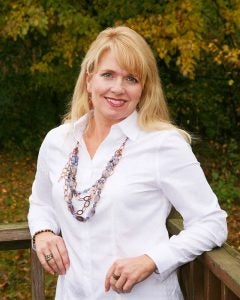Michele Payn wants the guilt at the grocery store to end. Payn — who is a professional speaker, agriculture advocate, author, and mom — is bringing a positive message about agriculture directly to consumers.
Payn’s first book, “No More Food Fights” (2013) is a two-sided book. The first side is from the farm prospective and focuses on Payn’s six steps to having a more productive conversation with consumers. Payn, a longtime speaker on behalf of the industry, encourages readers to more effectively share their agriculture story whether the reader is a rancher in Colorado or a dairy farmer in Indiana. The book then physically inverts, and the second part focuses on food and the consumer.
“Honestly, that was the side that gave me permission to write the book because way back then I didn’t think there would be a lot of interest just on the farm side,” she said.
The food side concentrates on common sense ways to look at food. It is the precursor to Payn’s second book, “Food Truths from Farm to Table: 25 Surprising Ways to Shop and Eat without Guilt.”
In her second book, Payn focuses on the claims and the many ways consumers are taught to fear their food, a commonality she said is shared by many grocery shoppers across the country. Payn has organized the book by grocery store aisle, answering consumer’s fears one food group at a time. In fact, the book has been accredited as approved reading for continuing education for registered dietitians. Having the ear of dietitians and others in the community is a win for Payn and agriculture.
The idea of sharing your ag story and serving the agriculture industry as an advocate is familiar to many in the industry, but Payn said her premise looks at the issue from a unique vantage point. The feedback Payn has received from consumers has been positive as the book seems to answer many of the questions that loom large in consumers’ minds about production methods.
“My premise is that we need to meet at the center of the plate and understand different perspectives,” she said. “We can respect that just as I have choice to farm the best way I know how to take care of my cattle, you have a choice to go to the grocery store and buy food the best way you know how for your family.”
Making food and farm decisions, Payn said, should be based on facts rather than emotion or misinformation.
“It’s not just about telling your story or trying to persuade people to our way of thinking,” she said. “It’s about stopping and listening and connecting at the center of the plate.”

To make the center of the plate concept more concrete, the first book has a shared chapter aimed at both producers and consumers about connection.
Payn said she has seen a shift toward conversations between consumers and producers over her speaking and advocacy career that began in 2001. She was one of the pioneers of the concept of sharing ag stories, and it remains one of her priorities.
“I’ve seen some improvement,” she said. “Especially with the advent of social media and some tools like AgChat and FoodChat, that people are working together. Are we all the way there? No. Does it help? Absolutely.”
Through the research for her books and her speaking career, Payn has a network of producers from all aspects of the industry, from cattle to canola. She is impressed with the technologies that producers have incorporated into their operations, but their personal stories remain her preference.
“There is a lot of thought put into taking care of our land and animals,” she said. “In ‘Farm Truths from Farm to Table,’ I interviewed 55 people, predominately farmers and ranchers, but also veterinarians, food scientists, dietitians, and food professionals.”
Payn listened intently as each person she interviewed spoke about their production step by step. For example, Payn interviewed a canola grower in Canada, a crop she was unfamiliar with. He spoke about his production from ground preparation to harvest.
“What I have found is you have to have a high level of understanding about the practice to be able to translate a story to other people,” she said.
Through her interviews, Payn was also able to know the producers on a personal level. For example, the aforementioned canola grower, Dale Leftwich, found that GMO insulin allows his daughter who was diagnosed with diabetes, a higher quality of life. For him, science and life intersect and allow his family to thrive.
Within the professional speaking community, Payn hears from her peers who are not involved in agriculture about their frustrations at the grocery store and, conversely, that engaging with her book and her social media messaging that they, too, feel empowered at the grocery store.
Payn and her daughter show registered Holstein cattle, and Payn posts information about the aspects of this life on social media, from winning to shipping one of their favorite cows.
“What I find without fail in personal conversations is that if someone has a question mark when they hear a claim from the Humane Society [of the United States] or other animal-rights activist groups, and we can keep that conversation open, we can keep the trust people have invested in farmers and ranchers,” she said.
“No one cares about your research and on one cares about your practices until they know you as a human. We have to respect that buying food as a mom is a personal responsibility for my family.”
The food consumers put on the table for their families is a truly personal choice and one that is complicated by claims against the industry. Agriculture has long been encouraged to share personal stories rather than answering emotional questions with statistics and data.
“I always tell people, ‘Don’t dump data and don’t puke science on people’s shoes,’” she said. “No one cares about your research and no one cares about your practices until they know you as a human. We have to respect that buying food as a mom is a personal responsibility for my family.”
Connecting with consumers on the human level at the center of the plate not only maintains the conversation between producers and consumers but also shows mutual respect and maintains trust in producers.
“People will forget the perfect sound bite you were trained to give, they will forget exactly how you farm or ranch, but they will never forget the way you make them feel about their food,” she said. “The data doesn’t do it.”



